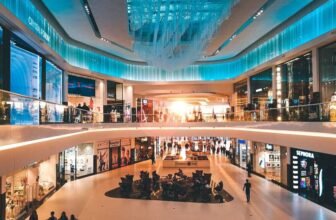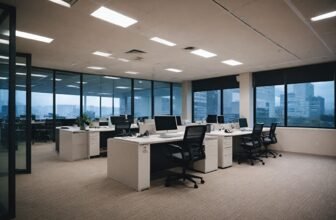
The Impact of Biophilic Design on Employee Productivity
In the modern age of architecture and workplace design, there is a growing emphasis on not just functionality, but also on how spaces influence human well-being and performance. Among the many design philosophies emerging from this shift, biophilic design stands out as a holistic approach that reconnects people with nature. As companies increasingly prioritize employee satisfaction and productivity, biophilic design is making its way into offices around the world. But what exactly is biophilic design, and how does it influence productivity.
Biophilic design stems from the term “biophilia,” which means “love of life or living systems.” Coined by biologist Edward O. Wilson in the 1980s, the concept proposes that humans have an innate tendency to seek connections with nature and other forms of life. Biophilic design applies this idea to the built environment, integrating natural elements into spaces to create a healthier and more engaging atmosphere.
Rather than merely placing a few plants around a room, biophilic design involves a comprehensive strategy that includes natural light, ventilation, materials, views, shapes, and even sounds and smells. The ultimate goal is to create environments that mimic natural ecosystems, thereby enhancing the emotional and psychological health of occupants.
The Five Senses of Biophilic Design
Biophilic design works by engaging the five senses, sight, sound, smell, touch, and taste, to create a deeply immersive natural experience.
- Sight: Visual connection to nature is the most obvious component of biophilic design. This includes the presence of plants, water features, natural lighting, and views of landscapes or green spaces. Patterns, colors, and textures that mimic nature (biomimicry) also enhance visual appeal.
- Sound: The use of natural sounds like flowing water, bird songs, or rustling leaves can reduce stress and improve focus. Soundscapes in the office can be curated to mimic those found in natural settings.
- Smell: Incorporating natural scents like essential oils, fresh flowers, or wood can evoke positive emotions and memories, which contributes to overall well-being.
- Touch: Tactile experiences such as wooden surfaces, stone textures, or soft moss walls provide sensory engagement that connects people to the natural world.
- Taste: While less commonly engaged in the workplace, edible gardens or herb walls can bring a unique biophilic element, especially in communal spaces like cafeterias.
Advantages of Biophilic Design
Implementing biophilic design in the workplace comes with numerous benefits, particularly when it comes to productivity and well-being.
- Improved Employee Productivity: Numerous studies have shown that employees working in spaces enriched with natural elements are more focused, creative, and productive. Access to natural light alone can increase productivity by up to 18%.
- Reduced Stress and Fatigue: Natural environments have a calming effect. Biophilic design helps reduce cortisol levels, heart rate, and blood pressure, contributing to a more relaxed and balanced work atmosphere.
- Enhanced Cognitive Function: Nature-inspired environments stimulate mental clarity and improve memory retention. Employees tend to make fewer mistakes and show greater cognitive flexibility.
- Increased Job Satisfaction: A visually and sensorially appealing workplace fosters greater job satisfaction and morale. Employees feel more connected and cared for by their employers.
- Lower Absenteeism: Healthier environments contribute to fewer sick days and overall better physical and mental health.
Disadvantages of Biophilic Design
While the benefits are compelling, there are some challenges and disadvantages associated with implementing biophilic design.
- Cost of Implementation: Incorporating natural elements, especially on a large scale, can be costly. From living walls to sophisticated lighting systems, the initial investment may be high.
- Maintenance: Natural features like plants and water systems require ongoing maintenance. Without proper care, these features can deteriorate and become eyesores or health hazards.
- Design Complexity: Integrating biophilic principles into existing structures can be architecturally complex and may require professional guidance.
- Misinterpretation of Concept: Some designers may misunderstand biophilic design as simply adding greenery. Without a holistic approach, the design may fail to deliver its intended benefits.
- Potential Allergens: Introducing certain plants or natural materials may trigger allergies among sensitive individuals, requiring careful selection of elements.
A Famous Biophilic Architect: Stefano Boeri
One of the most renowned architects associated with biophilic design is Stefano Boeri. An Italian architect and urban planner, Boeri gained international acclaim for his vertical forest projects, most notably the Bosco Verticale (Vertical Forest) in Milan. This pair of residential towers incorporates over 900 trees and 20,000 plants, effectively creating a vertical ecosystem within an urban setting. Boeri’s work showcases how urban development and nature can coexist in a mutually beneficial relationship.
Example of Biophilic Design: Amazon Spheres
A shining example of biophilic design in the workplace is the Amazon Spheres in Seattle, Washington. These glass domes serve as a workspace and botanical garden for Amazon employees. Containing over 40,000 plants from around the world, the Spheres offer a unique environment where employees can collaborate, relax, and work amidst lush greenery. The design emphasizes natural light, open spaces, and biodiversity, promoting mental well-being and innovation.
Materials Used in Biophilic Design
Biophilic design emphasizes the use of natural and sustainable materials that connect users to the environment. Some common materials include:
- Wood: Offers warmth and texture. Often left in its raw or minimally treated form.
- Stone: Adds a sense of permanence and groundedness.
- Water Features: Use of fountains, aquariums, or water walls.
- Bamboo: A fast-growing, renewable resource that adds an exotic, organic touch.
- Natural Fabrics: Such as wool, cotton, or linen.
- Green Walls and Roofs: Living plant installations that enhance air quality and aesthetics.
- Recycled and Sustainable Materials: Encouraging environmental responsibility.
These materials are often complemented by design choices that allow for ample daylight, natural ventilation, and views of the outdoors.
Who is the Father of Biophilic Design?
The title of “Father of Biophilic Design” is often attributed to Stephen R. Kellert, a social ecologist and professor at Yale University. Kellert expanded upon Edward O. Wilson’s biophilia hypothesis and played a crucial role in defining the principles and practical applications of biophilic design. His work emphasized the importance of connecting the built environment to natural systems and laid the foundation for many of the practices used today.
The Future of Workspaces with Biophilic Design
As the nature of work continues to evolve, especially in a post-pandemic world, the demand for healthier and more adaptable workplaces is on the rise. Companies are recognizing that investing in employee well-being pays off in the form of increased productivity, lower turnover rates, and enhanced corporate image.
Biophilic design is not a fleeting trend but a necessary evolution in how we think about the spaces we inhabit. It aligns with sustainability goals, supports mental and physical health, and fosters a deeper connection between people and the planet.
Incorporating biophilic principles is not limited to new constructions. Even existing offices can benefit from thoughtful renovations that introduce natural elements. Whether it’s through daylight optimization, indoor plants, or the use of eco-friendly materials, every step toward a more nature-integrated workspace makes a difference.
In conclusion, biophilic design is a powerful tool in reshaping the modern workplace. By tapping into our intrinsic connection to nature, it has the potential to revolutionize how we work, think, and feel, turning sterile office environments into vibrant ecosystems of creativity and well-being. image/goodearthplants





